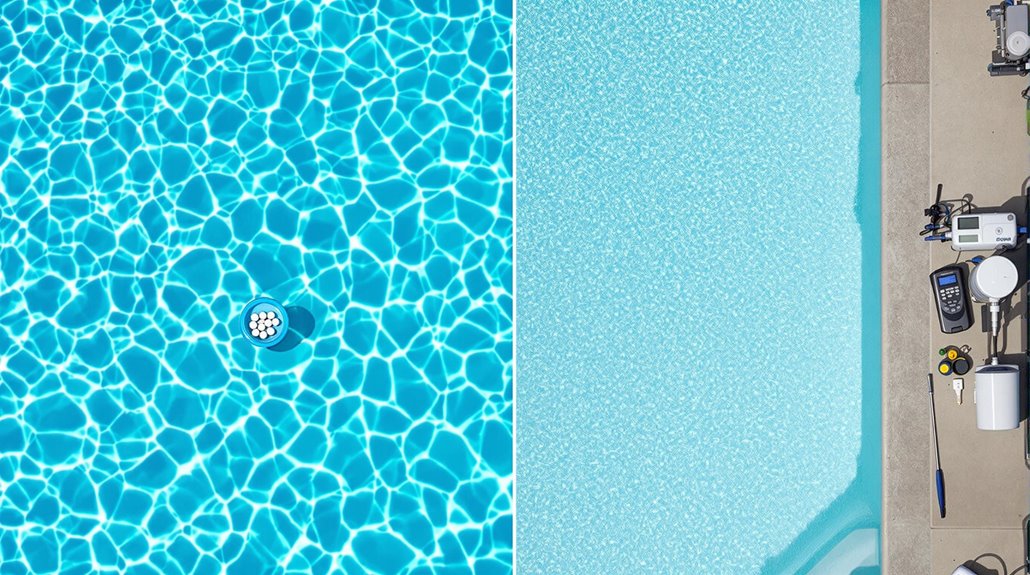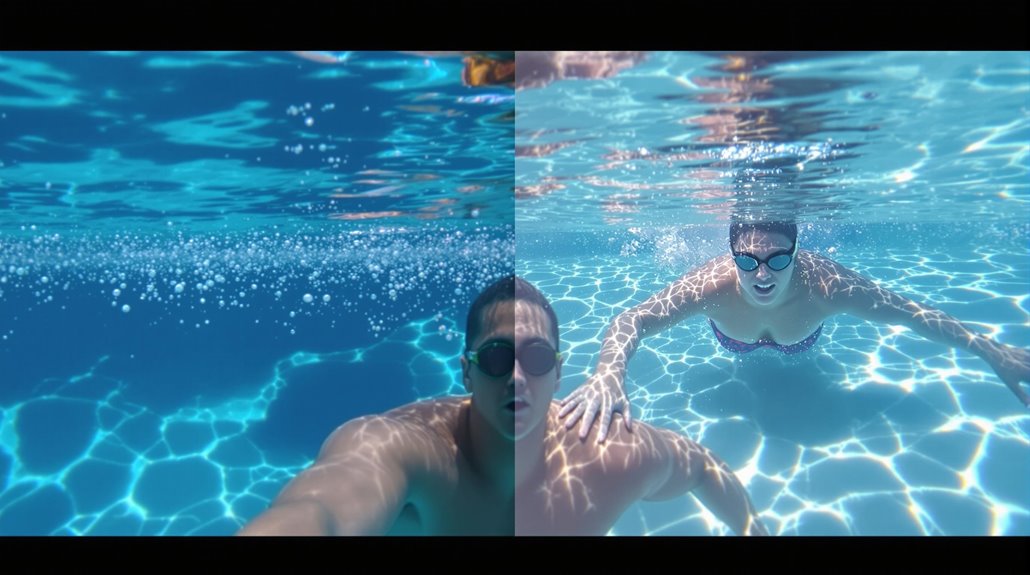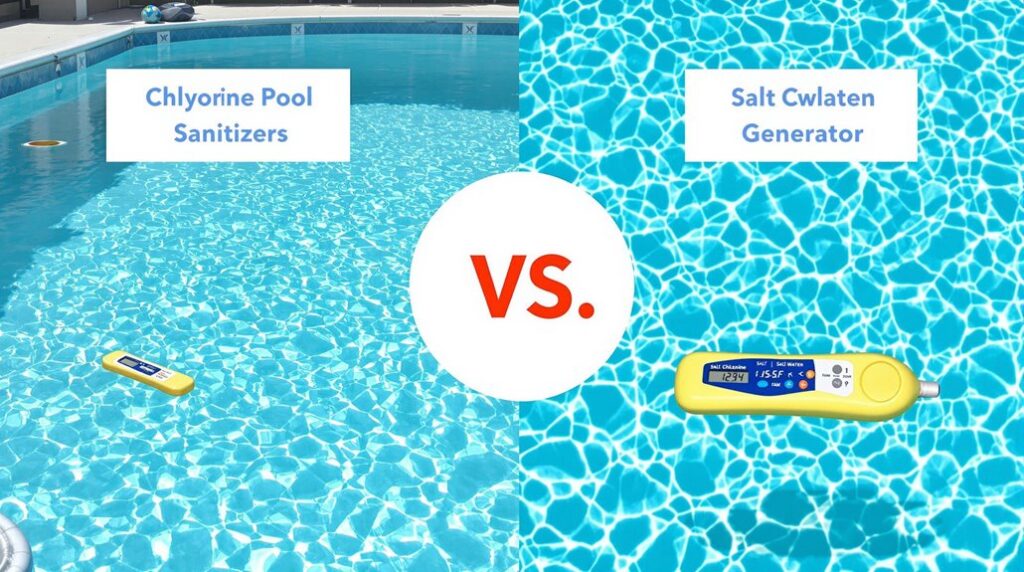Your choice between a chlorine or saltwater pool system depends on several key factors. Saltwater pools offer gentler chemistry with fewer irritants, silkier-feeling water, and automated chlorine generation, but they cost more initially. Traditional chlorine pools are less expensive upfront and simpler to maintain, though they require more frequent chemical additions and monitoring. Consider your budget, desired maintenance routine, and swimming comfort to determine which option best suits your lifestyle – but there’s much more to investigate about each system.
Understanding Pool Chemistry and Functionality

Upon maintaining a pool system, understanding the core chemical parameters is essential for proper functionality and safety. You’ll need to monitor free chlorine levels, which typically range from 2-6 ppm in traditional pools and 1-3 ppm in saltwater systems. pH balance is critical, with an ideal range of 7.4-7.6 to prevent corrosion and scaling. Crystal clear water depends on properly balanced pH levels that must be regularly tested and adjusted. Total alkalinity (60-150 ppm) stabilizes your pH levels, while calcium hardness requirements vary based on your pool’s surface material. For outdoor pools, cyanuric acid (30-60 ppm) protects chlorine from UV degradation. In saltwater systems, the salt-to-chlorine conversion happens through electrolysis, maintaining 2500-3500 ppm salt levels. Regular testing and adjustment of these parameters will guarantee your pool’s peak performance and longevity. If chemical tests indicate issues, systematic troubleshooting can help identify and resolve imbalances quickly.
Comparing Initial and Long-term Costs
While considering a pool installation, understanding both upfront and recurring costs helps you make an informed decision for your specific situation. Initial installation costs for traditional chlorine pool systems typically run around $23,000, which includes essential equipment such as pumps, filters, and plumbing components. This baseline investment serves as a starting point for your budget planning.
Before committing to either system, you’ll want to calculate beyond these upfront costs. Consider factors such as your region’s climate, expected pool usage, and local maintenance service rates. You’ll also need to factor in ongoing expenses such as chemicals, water testing supplies, and potential equipment replacements. By examining both immediate and long-term financial implications, you’ll be better positioned to choose a pool system that aligns with your budget and lifestyle needs.
Health Benefits and Swimmer Experience

Three key health factors distinguish saltwater and chlorine pool systems: eye comfort, skin health, and respiratory impact. If you’re sensitive to chemicals, you’ll appreciate that saltwater pools produce fewer chloramines, reducing eye redness and nasal irritation. Your skin won’t feel more dry or itchy after swimming, and the salt acts as a natural exfoliant.
For respiratory health, saltwater systems create a more breathable environment with lower chemical exposure, making them ideal if you have asthma or allergies. You’ll notice the water feels silkier and softer, akin to natural tears, providing a spa-like experience. The gentler chemistry also helps preserve your swimwear’s colors and protects against skin conditions like eczema and psoriasis, while minimizing the harsh chemical smell typically associated with traditional pools.
Daily Maintenance and Upkeep Requirements
Maintaining your pool’s water chemistry requires daily attention regardless of whether you’ve chosen a saltwater or traditional chlorine system. You’ll need to check pH levels between 7.2-7.6 and chlorine concentration at 1-3 ppm for both types. While chlorine pools need manual tablet or liquid additions, saltwater systems generate chlorine automatically but require salt level monitoring between 2,700-3,400 ppm.
Your daily routine should include skimming debris, brushing walls, and checking pump baskets to guarantee proper circulation. Plan to vacuum your pool floor once or twice weekly, and run your pump 8-12 hours daily. Regular heater inspections will extend equipment lifespan and prevent costly repairs. Maintaining crystal clear water requires consistent testing and adjustment of chemical levels. If your pool becomes cloudy, proper filtration is essential to restore water clarity. Saltwater pools need less frequent shocking but require periodic salt cell cleaning, while chlorine pools need weekly shock treatments to eliminate irritating chloramines. Regular maintenance of your pool filter system will significantly increase its operational life and efficiency. Establishing safety protocols for your pool area helps prevent accidents and ensures a worry-free swimming experience.
Frequently Asked Questions
Can I Convert My Existing Chlorine Pool to a Saltwater System?
Yes. Conversion requires:
- Installing a salt chlorine generator
- Adding pool-grade salt
- Checking metal components for salt compatibility
What Happens to Pool Equipment if There’s a Power Outage?
Pool equipment risks during outages:
- Pump/heater surge damage
- Stagnant water from lack of circulation
- Salt system corrosion
Solutions:
- Install surge protectors
- Circulate water manually
Do Saltwater Pools Freeze at Different Temperatures Than Chlorine Pools?
Saltwater pools freeze at 28°F (-2°C); chlorine pools freeze at 32°F (0°C). Salt acts as an antifreeze, lowering the freezing point.
Is It Safe to Use Pool Water for Garden Irrigation?
Pool water damages plants due to high chlorine or salt content that harms roots, soil, and vegetation.
How Does Pool Size Affect the Choice Between Saltwater and Chlorine?
Saltwater systems: cost-effective for pools >20,000 gallons
Traditional chlorine: better for pools <10,000 gallons

